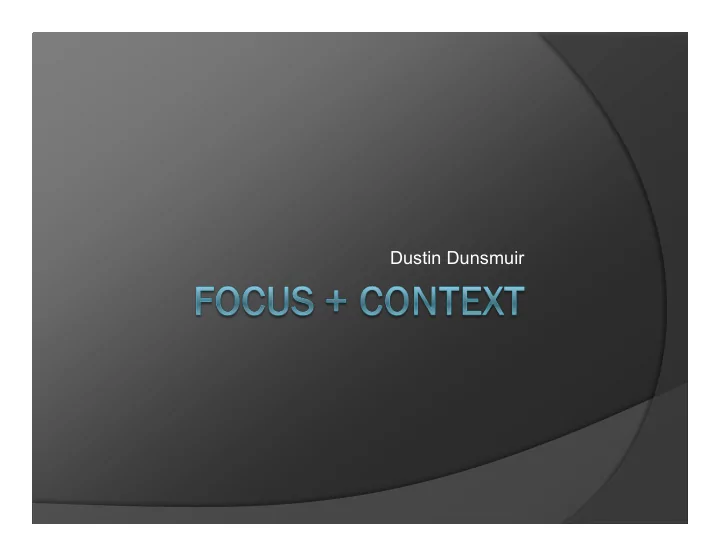

Dustin Dunsmuir
Papers • Keeping things in context: a comparative evaluation of focus plus context screens, overviews, and zooming. Patrick Baudisch, Nathaniel Good, Victoria Bellotti, and Pamela Schraedley. CHI 2002. • Evaluation of Semantic Fisheye Zooming to Provide Focus+Context. Andrew J. Afram, John Briedis, Daisuke Fujiwara, Robert J.K. Jacob, Caroline G.L. Cao, and David Kahle. Human Factors and Ergonomics Society 51st Annual Meeting, 2007. p.459-463. • An Improved Fisheye Zoom Algorithm for Visualizing and Editing Hierarchical Models. Tobias Reinhard, Silvio Meier, and Martin Glinz. Second International Workshop on Requirements Engineering Visualization, 2007.
Keeping Things in Context: A Comparative Evaluation of Focus Plus Context Screens, Overviews, and Zooming.
Interfaces
Field Study • Interviewed fourteen experts • Multi-scale content: Static Dynamic Task Graphic Design Chip Design Air Traffic Control Document Poster: 1m Wafer: 12cm Zone: 50km Smallest Object Text: 1cm Conductive Path: 3 µ m Airplane: 50m Smallest Detail Align: 0.5mm Grid 0.5 µ m 25m steps Ratio 2,000 240,000 2,000
Static Data Study Circuit board Path tracing Verify connected pairs of pins Map of London distance comparison Hotels and conference location marked Which one is closer by taxi?
Results Focus + Context 21% and 36% faster and also preferred by the majority Overview + Detail slower due to switching views Problems noted: Context not very usable, too blurry Users cast shadows on display
Dynamic Data Study Only overview + detail and focus + context Driving simulation Subjects had to avoid rocks (in context) and nails (in focus) Focus + context had one third of the obstacles hit, and it was preferred Peripheral vision used
Critique Innovative method of combining display techniques to make focus + context Tasks intelligently chosen and strong results supporting focus + context Are results useful in the future when it will be easier to have full screen at high res?
Evaluation of Semantic Fisheye Zooming to Provide Focus + Context.
Visual Understanding Environment (VUE) Concept map application for the classroom Digital Library Objects connected by user defined relations Canvas for drawing and creating objects
Problems Difficult to view concept maps larger than dozens of nodes Using geometric zooming… Removes context Nothing added by zooming, nodes just get larger (not semantic) Must instead look at detail in another window
Solution Semantic Fisheye Zoom Activated by mouse over, gives detail that would otherwise be in a popup window Justified by earlier work: An evaluation of semantic fisheye views for opportunistic search in an annotated image collection. Paul Janecek and Pearl Pu. International Journal on Digital Libraries, 2005. p.42-56.
Study Compared semantic fisheye zoom to control interface (normal zoom) Expected new zoom to… Be faster to use Be preferred Allow for remembering more information Did not expect higher accuracy
Setup Students answered 3 question sets while using interface: Questions involving a single node 1. …two or more nodes 2. …an overall understanding of the concept map 3. 4 th question set answered without interface (by memory)
Results • Significant: Control faster in set 1 Accuracy in Set 4 was higher for fisheye Better learning of information No need to integrate across displays
Critique Builds upon previous studies Makes modest assumptions Study performed like real world use How was preference for semantic fisheye zoom reported? How many nodes were in the graph?
An Improved Fisheye Zoom Algorithm for Visualizing and Editing Hierarchical Models
ADORA Eclipse plugin Analysis and Description of Requirements and Architecture Object oriented modeling method, display as nested hierarchy Demo http://www.ifi.uzh.ch/rerg/research/projects/adora/
Algorithm Properties Commutative zoom operations Preserve the mental map Orthogonality ordering Proximity relations Topology Layout Adjustment and the Mental Map. Kazuo Misue, Peter Eades, Wei Lai, and Kozo Sugiyama. Journal of Visual Languages and Computing, 6(2), 1995. p.183–210.
Interval Structure
Commutative Intervals remembered and have minimum size
Multipurpose Add and remove done using algorithm Add as large as possible, then expand Zoom out to pixel, then remove Resize and move done using remove and then add Filtering (Show/Hide) remember position
Critique Flexible and powerful, but could collect large amounts of intervals over time Moving multiple nodes - weird behavior Demo Has Table Lens like reaction to zooming when many nodes are lined up Demo
Recommend
More recommend